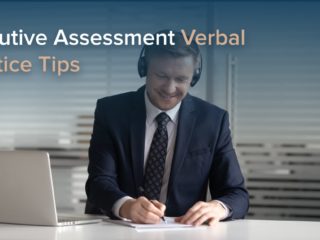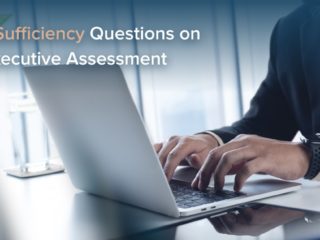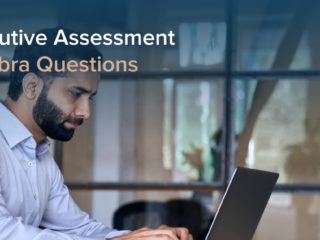|
Getting your Trinity Audio player ready...
|
If you’re considering taking the Executive Assessment to apply to business schools’ executive MBA programs or another program that accepts the EA, you’re likely aware that, in addition to the Integrated Reasoning and Quantitative Reasoning sections, the EA includes a Verbal Reasoning section.
So, you may be wondering what types of questions appear on the Verbal Reasoning section of the EA and how to prepare for it. In this article, I’ll cover the three main EA verbal question types and provide some tips for mastering each of them. First, however, let’s discuss some basics of the EA Verbal Reasoning section.
- The Executive Assessment Verbal Reasoning Section
- Executive Assessment Verbal Question Types
The Executive Assessment Verbal Reasoning Section
The Verbal Reasoning section of the Executive Assessment tests skill in comprehending written material, analyzing and evaluating arguments, and correcting material to effectively express ideas in standard written English. Another way of looking at the EA Verbal section is that it’s a test of skill in noticing details and issues and using logic to arrive at correct answers.
The EA Verbal section is made up of 14 multiple choice questions that a test-taker has 30 minutes to answer. The questions are presented in two modules of 7 questions each, and the level of difficulty of the questions that appear in the second module depends on the test-taker’s performance on the questions on the first module.
So, depending on how many of the questions in the first module a test-taker gets correct, the difficulty of the questions in the second module could be relatively high, relatively low, or somewhere in between.
Of the 14 questions that make up the Verbal section of the EA, 6 are Sentence Correction questions, 4 are Critical Reasoning questions, and 4 are Reading Comprehension questions. Let’s now discuss each of these, starting with Sentence Correction questions.
Executive Assessment Verbal Question Types
EA Sentence Correction Questions
EA Sentence Correction questions test skill in determining which version of a sentence most correctly and effectively expresses an idea. The format of Sentence Correction questions is the following.
A Sentence Correction question first presents a sentence, and all or part of the sentence is underlined. That sentence is followed by five answer choices, which present five different versions of the underlined portion of the original sentence.
The first answer choice, choice (A), repeats the underlined portion of the original sentence. In other words, the words and punctuation underlined in the original sentence will make up answer choice (A). Each of the other four choices offers an alternative way of wording the underlined portion of the sentence.
The task of a test-taker in answering a Sentence Correction question is to identify the answer choice that produces the best version of the sentence in terms of both grammatical correctness and meaning conveyed.
KEY FACT:
The task of a test-taker in answering a Sentence Correction question is to identify the answer choice that produces the best version of the sentence in terms of both grammatical correctness and meaning conveyed.
To see how EA Sentence Correction questions work, let’s consider a sample EA Sentence Correction question:
EA Sentence Correction Example
Potential discoveries of signs of carbon-based life on another planet have captured the imagination of astronomers being the focus of research for some.
- have captured the imagination of astronomers being
- has been captured in imagination of astronomers to be
- is captured in the imagination of astronomers and is the
- have captured the imagination of astronomers and are
- captures the imagination of astronomers for
Solution:
As we just discussed, to correctly answer this question, we have to identify the answer choice that produces the best version of the sentence in terms of both grammatical correctness and meaning conveyed. So, to find the correct answer, we consider each sentence version, looking for errors in grammar or construction and considering whether it effectively conveys a meaning that makes sense.
The first thing we notice is that we can eliminate choices (B), (C), and (E) on the basis of grammar issues because the verbs “has,” “is,” and “captures” in those versions don’t agree with the plural subject of the sentence, which is “discoveries.” So, we are left with two choices, (A) and (D), both of which use the plural verb “have,” which agrees with “discoveries.”
Now, reading each of the remaining sentence versions, we see that the (A) version conveys a meaning that doesn’t make sense. After all, “astronomers being the focus of research” conveys the illogical meaning that astronomers, rather than “discoveries of carbon-based life,” are “the focus of research.” So, choice (D) is the correct answer to this Sentence Correction question, since only the sentence version produced by choice (D) both is grammatically correct and conveys a meaning that makes sense.
Now that we have a basic understanding of how EA Sentence Correction questions work, let’s discuss some key tips for Sentence Correction mastery.
Tips for EA Sentence Correction Mastery
The correct answer to a Sentence Correction question may not be ideal. – When answering a Sentence Correction question, look for the best choice, not a perfect choice because, often, the correct answer will produce an OK, but not ideal, sentence.
Pay attention to meaning conveyed. – As we saw in the above example question, often a choice in a Sentence Correction question will be incorrect because the sentence that choice produces conveys a meaning that doesn’t make sense. So, while learning grammar rules is an important aspect of Sentence Correction mastery, we also have to develop skill in determining whether a sentence conveys a meaning that makes sense.
Practice by carefully analyzing sentence versions. – The most effective way to develop strong Sentence Correction skills is to practice Sentence Correction untimed, analyzing practice questions choice by choice and focusing on understanding and accuracy. Then, once you’ve become skilled at seeing the issues in the sentence versions and getting questions correct, you can seek to speed up to the pace you’ll have to keep on test day.
TTP PRO TIP:
To master EA Sentence Correction, keep in mind that the correct answer to a Sentence Correction question may not be ideal, pay attention to meaning, and practice by carefully analyzing sentence versions in practice questions.
Having gained a basic understanding of Sentence Correction and some ideas for mastering it, let’s now discuss the next type of EA Verbal question, Critical Reasoning questions.
EA Critical Reasoning Questions
EA Critical Reasoning questions test skill in analyzing and evaluating arguments. The format of Critical Reasoning questions is the following.
A Critical Reasoning question first presents a written stimulus, usually in the form of a passage of about 100 words or fewer. Following the stimulus are a question and five answer choices. To correctly answer the question, we have to determine which of the five answer choices is logically related to the stimulus in a particular way.
KEY FACT:
To correctly answer a Critical Reasoning question, we have to determine which of the five answer choices is logically related to the stimulus in a particular way.
To see how EA Critical Reasoning questions work, let’s consider a sample EA Critical Reasoning question:
EA Critical Reasoning Example
The Town of Seaford is projected to have a sizable budget deficit in the coming year. Meanwhile, every day, over 20,000 cars cross the North Bay Bridge into Seaford. Clearly, by charging a toll to cross the North Bay Bridge, the Town of Seaford can generate enough revenue to cover its budget deficit.
Which of the following does the author assume in arriving at the above conclusion?
- Tax rates set by the Town of Seaford could be increased substantially.
- If the Town of Seaford does not cover its budget deficit, it will be forced to declare bankruptcy in the coming year.
- People will continue to use the North Bay Bridge to get to Seaford even if they must pay a toll to do so.
- The Town of Seaford has been spending money on wasteful projects.
- The number of cars that cross the North Bay Bridge every day will not increase in the near future.
Solution:
The process of answering this Critical Reasoning question is the following. First, we carefully read and seek to fully understand the passage. Then, we read the question stem to find out how the correct answer must be related to the passage, and finally we choose the choice that is related to the passage in that way.
In the case of this question, the correct answer must state an assumption upon which the argument in the passage depends. The conclusion of the argument is “by charging a toll to cross the North Bay Bridge, the Town of Seaford can generate enough revenue to cover its budget deficit.” So, the correct answer is choice (C). After all, in order to go from the fact that “every day, over 20,000 cars cross the North Bay Bridge into Seaford,” to the conclusion that, “by charging a toll to cross the North Bay Bridge, the Town of Seaford can generate enough revenue to cover its budget deficit,” the author has to assume that “People will continue to use the North Bay Bridge to get to Seaford even if they must pay a toll to do so.”
Now that we have a basic understanding of how EA Critical Reasoning questions work, let’s discuss some key tips for Critical Reasoning mastery.
Tips for EA Critical Reasoning Mastery
Understanding the passage is the foundation of correctly answering a Critical Reasoning question. – To arrive at correct answers to Critical Reasoning questions carefully read and seek to fully understand the passages.
To develop strong Critical Reasoning skills, analyze every answer choice when practicing. – For best results, when answering Critical Reasoning practice questions, treat every choice as a question to be answered, and seek to understand the relationship between each choice and the passage.
To master Critical Reasoning, focus on one question type at a time. – 10 types of Critical Reasoning questions appear on the EA. For best results, when learning, focus on one of these types of Critical Reasoning questions at a time to develop the specific skills necessary for answering that type of question before moving on to the next type.
TTP PRO TIP:
To master EA Critical Reasoning, keep in mind that understanding the passage is the foundation of correctly answering a Critical Reasoning question, analyze every answer choice when practicing, and focus on one question type at a time.
Having gained a basic understanding of Critical Reasoning and some ideas for mastering it, let’s now discuss the next type of EA Verbal question, Reading Comprehension questions.
EA Reading Comprehension Questions
EA Reading Comprehension questions test skill in understanding written material. The format of Critical Reasoning questions is the following.
The EA presents a passage about a topic, for example a business, social sciences, natural sciences, or historical topic. Along with the passage are presented four questions one at a time. Each of the questions has a question stem followed by five answer choices.
To correctly answer an EA Reading Comprehension question, we must find the answer choice that is supported by the passage.
KEY FACT:
To correctly answer an EA Reading Comprehension question we must find the answer choice that is supported by the passage.
To see how EA Reading Comprehension questions work, let’s consider a sample EA Reading Comprehension question:
EA Reading Comprehension Example
As a researcher with no college degree and little training, Jane Goodall was not influenced by the prevailing view in the scientific community that anthropomorphism — the attribution of human traits or purposes to non-humans — was a methodological flaw that inevitably results in loss of objectivity. Consequently, when she entered the Tanzanian wilderness to study chimpanzees, she was unimpeded from making certain groundbreaking discoveries that would forever change the way non-human animals are perceived. During her first period of field study in 1960, having observed chimpanzees’ use of touch to greet and comfort each other, Goodall concluded that they have unique personalities and human-like emotions. During this period, she also observed chimpanzees fashioning simple tools that they used to “fish” for termites. Since, at the time, the common wisdom was that humans alone modify objects to create tools, this discovery stunned the scientific world. Later, in 1970, her observation that chimpanzees seemed to express awe at the sight of a spectacular waterfall led her and others to believe that chimpanzees have experiences akin to human spirituality.
Goodall’s work convinced many of her peers that the mental, emotional, and spiritual characteristics of human and non-human animals lie on a continuum rather than on two sides of a dividing line. Harvard’s Stephen Jay Gould called this feat “one of the great achievements of twentieth-century scholarship.” Nevertheless, others have termed her work “anecdotal” or even “unbounded speculation” because, as diligent as it is, her conclusions are largely based upon a somewhat limited set of observations made by a single person. However, more recently, teams of researchers using empirical methods involving large samples have produced evidence indicating that her views reflect reality.
According to the passage, Jane Goodall’s observation that chimpanzees fashion simple tools
- was made while she was engaging in field study in 1970
- showed for the first time that termites are an important component of the diet of chimpanzees
- was disputed by most members of the scientific world
- showed a certain widely held conception to be false
- confirmed in a stunning manner what many of her peers had long suspected
Solution:
The process for answering this Reading Comprehension question is the following. First we read and understand the passage. Then, we read the question, and finally, we find the answer choice that states what the passage says about “Jane Goodall’s observation that chimpanzees fashion simple tools.”
By carefully considering what each choice says and comparing it with what the passage says, we see that the correct answer is choice (D). After all, the second to last sentence of the first paragraph of the passage says that “at the time, the common wisdom was that humans alone modify objects to create tools.” So, the observation that chimpanzees make tools, showed that “common wisdom,” or “widely held conception” to be false.
Now that we have a basic understanding of how EA Reading Comprehension questions work, let’s discuss some key tips for Reading Comprehension mastery.
Tips for EA Reading Comprehension Mastery
Read to understand. – EA Reading Comprehension tests skill in comprehending what passages say. So, for best results, don’t seek to use gimmicky strategies to answer Reading Comprehension questions. Instead, focus on truly understanding what the passage says.
Return to the passage to determine whether choices are supported. – When answering Reading Comprehension questions, keep in mind that the information needed for answering a Reading Comprehension question is right there in the passage. So, for best results, use that information by returning to the passage to determine whether answer choices are supported.
Learn to tell the difference between trap choices and correct answers. – Incorrect choices in Reading Comprehension questions are often written to appear to match what the passage says. So, for best results, learn to carefully compare each answer choice with what the passage says to determine whether a choice you’re considering is actually supported by the passage or is only written to resemble what the passage says.
TTP PRO TIP:
To master EA Reading Comprehension, read for understanding, return to the passage as necessary when answering questions, and beware of trap answer choices.
Now that you’re familiar with the types of questions that appear in the Verbal section of the EA, you’re ready to start mastering them. You may also want to check out this comprehensive guide to the Executive Assessment and learn how to use Executive Assessment practice tests during your EA prep.



